Analysis of Current Development in Accounting Thought, Semester 1
VerifiedAdded on 2022/11/13
|11
|2952
|390
Report
AI Summary
This report delves into the current developments in accounting, examining the historical cost basis of measurement, fair value, and the AASB framework. It discusses the advantages of the conceptual framework projects, comparing and contrasting government intervention with the framework's benefits. The report analyzes the relevancy of fair values versus historical cost to users within the AASB framework and highlights the merits of the historical method of accounting, emphasizing its simplicity, reliability, and objectivity. The discussion includes the impact of market changes on asset valuation and the importance of consistent, reliable financial information for economic decision-making. The report also explores the political influences on accounting standards and the role of the conceptual framework in providing legitimacy to standard-setting bodies. The analysis provides insights into the advantages and disadvantages of both the historical cost and fair value methods, providing a comprehensive overview of key accounting principles and their implications.
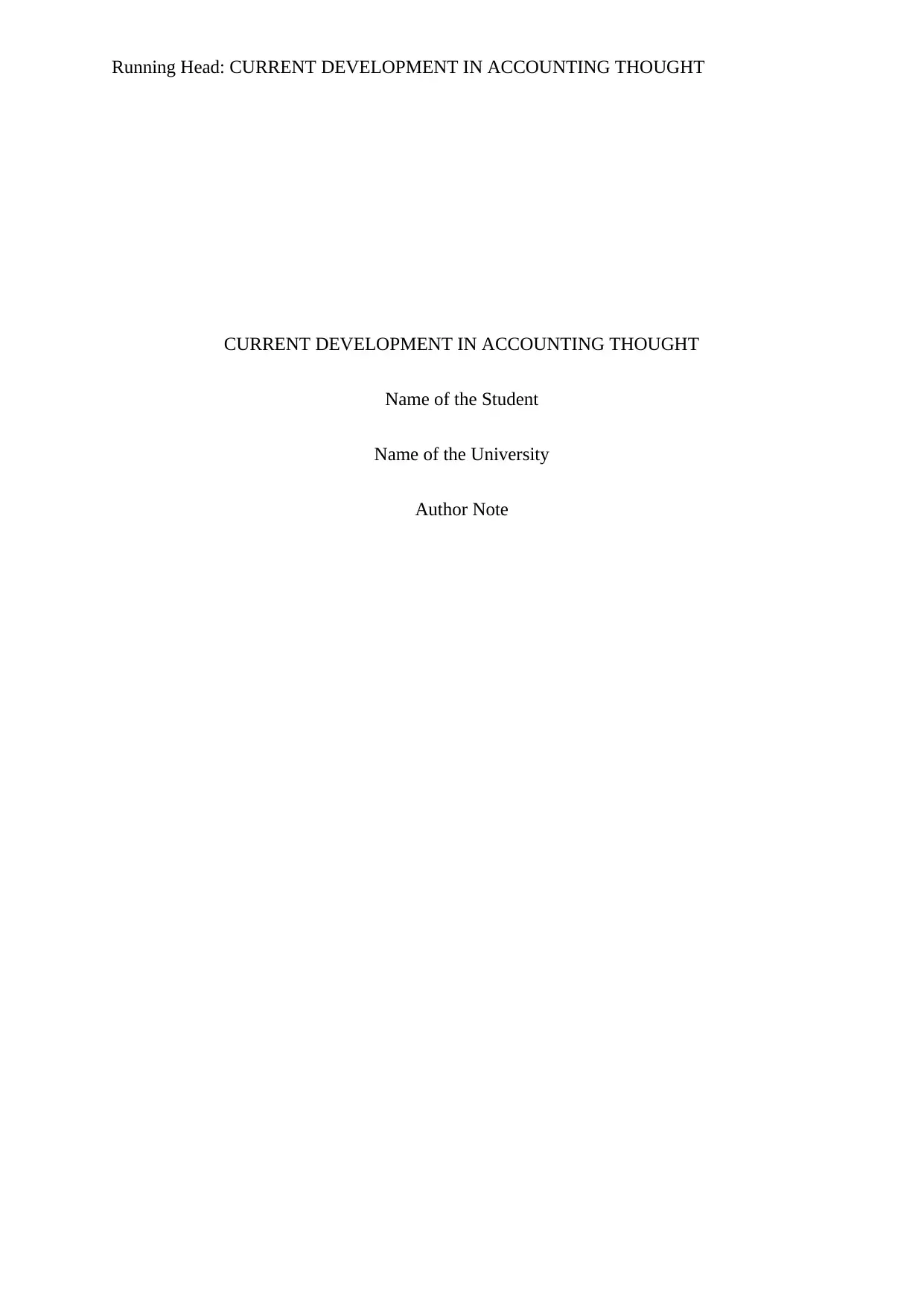
Running Head: CURRENT DEVELOPMENT IN ACCOUNTING THOUGHT
CURRENT DEVELOPMENT IN ACCOUNTING THOUGHT
Name of the Student
Name of the University
Author Note
CURRENT DEVELOPMENT IN ACCOUNTING THOUGHT
Name of the Student
Name of the University
Author Note
Paraphrase This Document
Need a fresh take? Get an instant paraphrase of this document with our AI Paraphraser
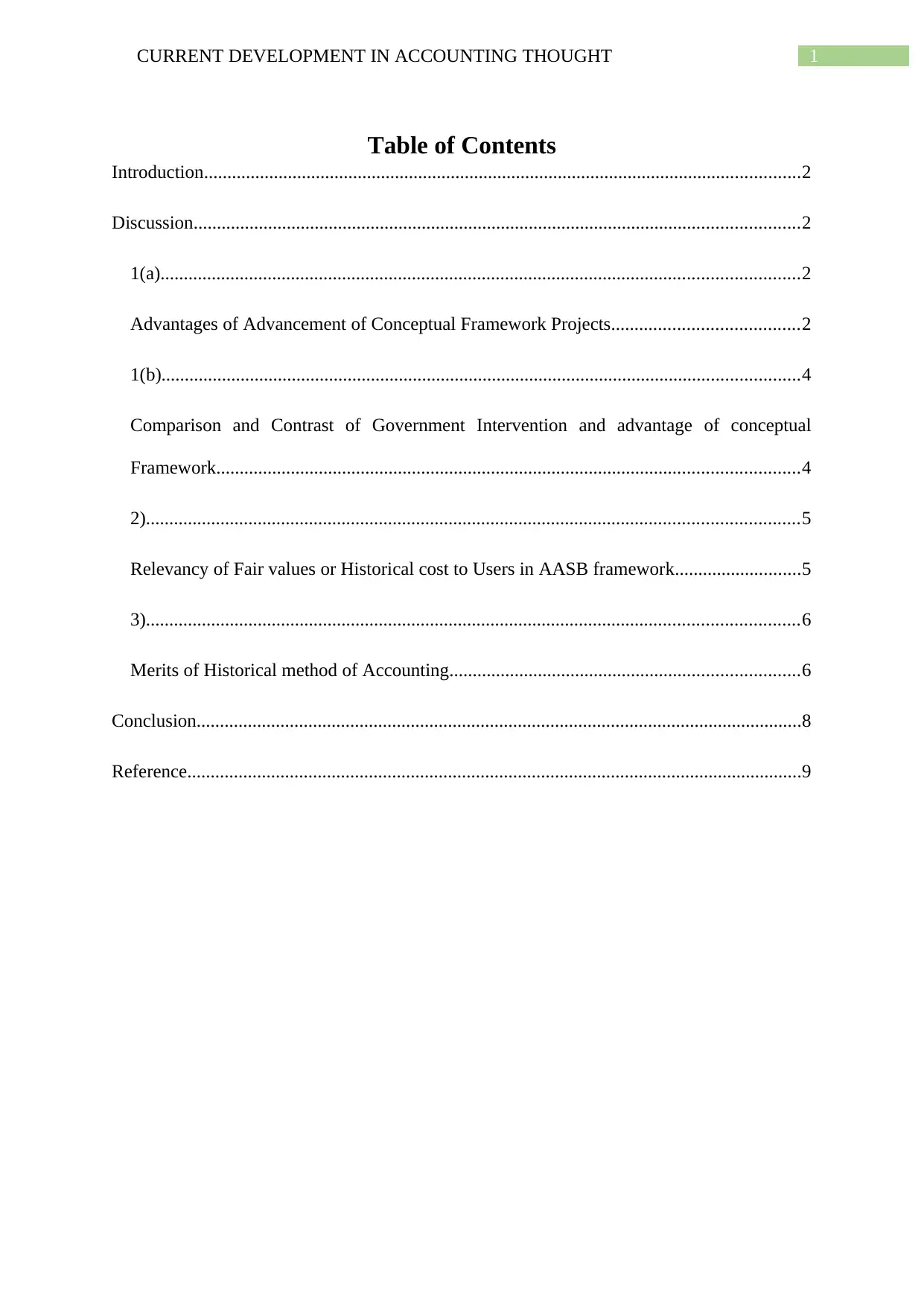
1CURRENT DEVELOPMENT IN ACCOUNTING THOUGHT
Table of Contents
Introduction................................................................................................................................2
Discussion..................................................................................................................................2
1(a).........................................................................................................................................2
Advantages of Advancement of Conceptual Framework Projects........................................2
1(b).........................................................................................................................................4
Comparison and Contrast of Government Intervention and advantage of conceptual
Framework.............................................................................................................................4
2)............................................................................................................................................5
Relevancy of Fair values or Historical cost to Users in AASB framework...........................5
3)............................................................................................................................................6
Merits of Historical method of Accounting...........................................................................6
Conclusion..................................................................................................................................8
Reference....................................................................................................................................9
Table of Contents
Introduction................................................................................................................................2
Discussion..................................................................................................................................2
1(a).........................................................................................................................................2
Advantages of Advancement of Conceptual Framework Projects........................................2
1(b).........................................................................................................................................4
Comparison and Contrast of Government Intervention and advantage of conceptual
Framework.............................................................................................................................4
2)............................................................................................................................................5
Relevancy of Fair values or Historical cost to Users in AASB framework...........................5
3)............................................................................................................................................6
Merits of Historical method of Accounting...........................................................................6
Conclusion..................................................................................................................................8
Reference....................................................................................................................................9
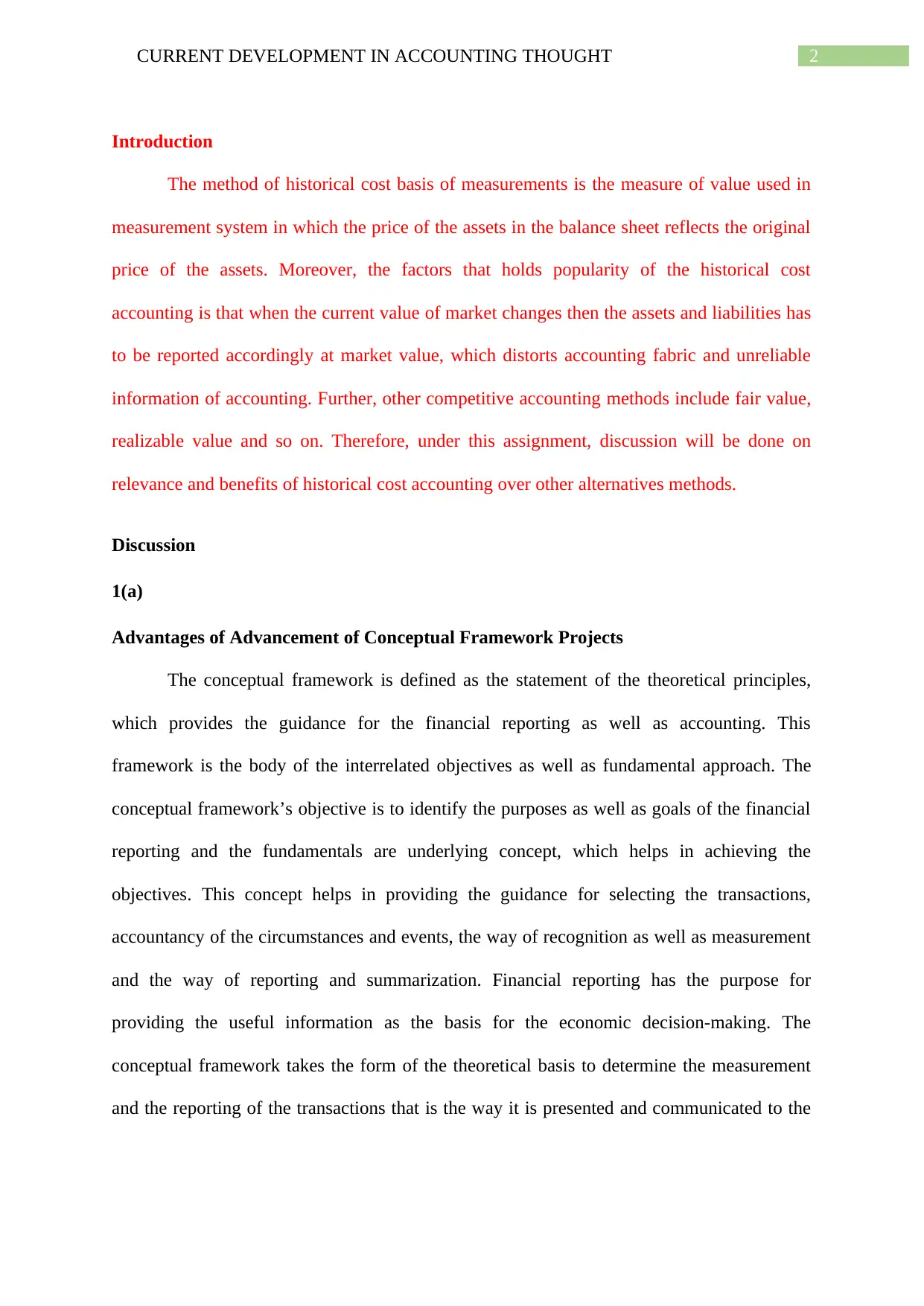
2CURRENT DEVELOPMENT IN ACCOUNTING THOUGHT
Introduction
The method of historical cost basis of measurements is the measure of value used in
measurement system in which the price of the assets in the balance sheet reflects the original
price of the assets. Moreover, the factors that holds popularity of the historical cost
accounting is that when the current value of market changes then the assets and liabilities has
to be reported accordingly at market value, which distorts accounting fabric and unreliable
information of accounting. Further, other competitive accounting methods include fair value,
realizable value and so on. Therefore, under this assignment, discussion will be done on
relevance and benefits of historical cost accounting over other alternatives methods.
Discussion
1(a)
Advantages of Advancement of Conceptual Framework Projects
The conceptual framework is defined as the statement of the theoretical principles,
which provides the guidance for the financial reporting as well as accounting. This
framework is the body of the interrelated objectives as well as fundamental approach. The
conceptual framework’s objective is to identify the purposes as well as goals of the financial
reporting and the fundamentals are underlying concept, which helps in achieving the
objectives. This concept helps in providing the guidance for selecting the transactions,
accountancy of the circumstances and events, the way of recognition as well as measurement
and the way of reporting and summarization. Financial reporting has the purpose for
providing the useful information as the basis for the economic decision-making. The
conceptual framework takes the form of the theoretical basis to determine the measurement
and the reporting of the transactions that is the way it is presented and communicated to the
Introduction
The method of historical cost basis of measurements is the measure of value used in
measurement system in which the price of the assets in the balance sheet reflects the original
price of the assets. Moreover, the factors that holds popularity of the historical cost
accounting is that when the current value of market changes then the assets and liabilities has
to be reported accordingly at market value, which distorts accounting fabric and unreliable
information of accounting. Further, other competitive accounting methods include fair value,
realizable value and so on. Therefore, under this assignment, discussion will be done on
relevance and benefits of historical cost accounting over other alternatives methods.
Discussion
1(a)
Advantages of Advancement of Conceptual Framework Projects
The conceptual framework is defined as the statement of the theoretical principles,
which provides the guidance for the financial reporting as well as accounting. This
framework is the body of the interrelated objectives as well as fundamental approach. The
conceptual framework’s objective is to identify the purposes as well as goals of the financial
reporting and the fundamentals are underlying concept, which helps in achieving the
objectives. This concept helps in providing the guidance for selecting the transactions,
accountancy of the circumstances and events, the way of recognition as well as measurement
and the way of reporting and summarization. Financial reporting has the purpose for
providing the useful information as the basis for the economic decision-making. The
conceptual framework takes the form of the theoretical basis to determine the measurement
and the reporting of the transactions that is the way it is presented and communicated to the
⊘ This is a preview!⊘
Do you want full access?
Subscribe today to unlock all pages.

Trusted by 1+ million students worldwide
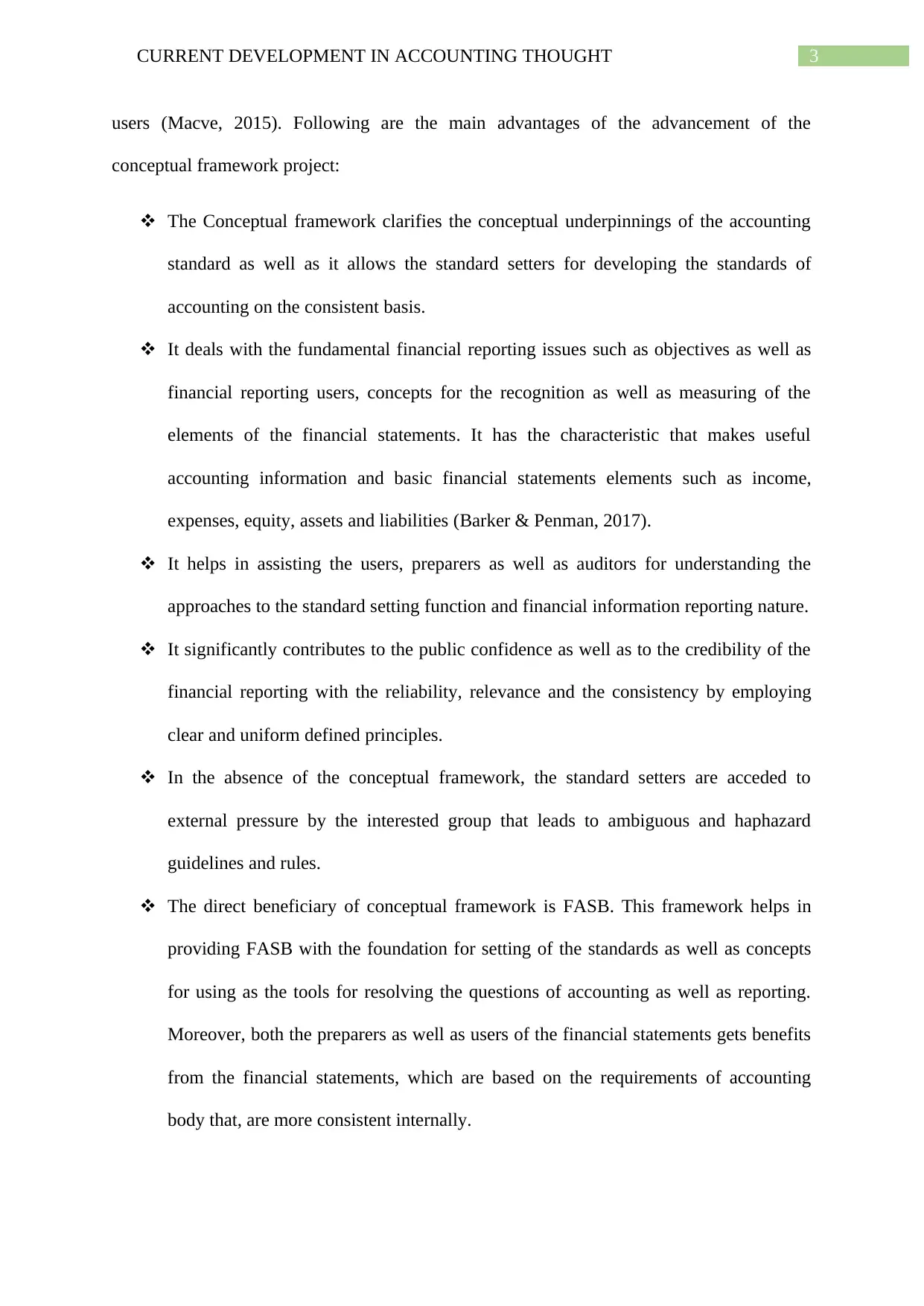
3CURRENT DEVELOPMENT IN ACCOUNTING THOUGHT
users (Macve, 2015). Following are the main advantages of the advancement of the
conceptual framework project:
The Conceptual framework clarifies the conceptual underpinnings of the accounting
standard as well as it allows the standard setters for developing the standards of
accounting on the consistent basis.
It deals with the fundamental financial reporting issues such as objectives as well as
financial reporting users, concepts for the recognition as well as measuring of the
elements of the financial statements. It has the characteristic that makes useful
accounting information and basic financial statements elements such as income,
expenses, equity, assets and liabilities (Barker & Penman, 2017).
It helps in assisting the users, preparers as well as auditors for understanding the
approaches to the standard setting function and financial information reporting nature.
It significantly contributes to the public confidence as well as to the credibility of the
financial reporting with the reliability, relevance and the consistency by employing
clear and uniform defined principles.
In the absence of the conceptual framework, the standard setters are acceded to
external pressure by the interested group that leads to ambiguous and haphazard
guidelines and rules.
The direct beneficiary of conceptual framework is FASB. This framework helps in
providing FASB with the foundation for setting of the standards as well as concepts
for using as the tools for resolving the questions of accounting as well as reporting.
Moreover, both the preparers as well as users of the financial statements gets benefits
from the financial statements, which are based on the requirements of accounting
body that, are more consistent internally.
users (Macve, 2015). Following are the main advantages of the advancement of the
conceptual framework project:
The Conceptual framework clarifies the conceptual underpinnings of the accounting
standard as well as it allows the standard setters for developing the standards of
accounting on the consistent basis.
It deals with the fundamental financial reporting issues such as objectives as well as
financial reporting users, concepts for the recognition as well as measuring of the
elements of the financial statements. It has the characteristic that makes useful
accounting information and basic financial statements elements such as income,
expenses, equity, assets and liabilities (Barker & Penman, 2017).
It helps in assisting the users, preparers as well as auditors for understanding the
approaches to the standard setting function and financial information reporting nature.
It significantly contributes to the public confidence as well as to the credibility of the
financial reporting with the reliability, relevance and the consistency by employing
clear and uniform defined principles.
In the absence of the conceptual framework, the standard setters are acceded to
external pressure by the interested group that leads to ambiguous and haphazard
guidelines and rules.
The direct beneficiary of conceptual framework is FASB. This framework helps in
providing FASB with the foundation for setting of the standards as well as concepts
for using as the tools for resolving the questions of accounting as well as reporting.
Moreover, both the preparers as well as users of the financial statements gets benefits
from the financial statements, which are based on the requirements of accounting
body that, are more consistent internally.
Paraphrase This Document
Need a fresh take? Get an instant paraphrase of this document with our AI Paraphraser
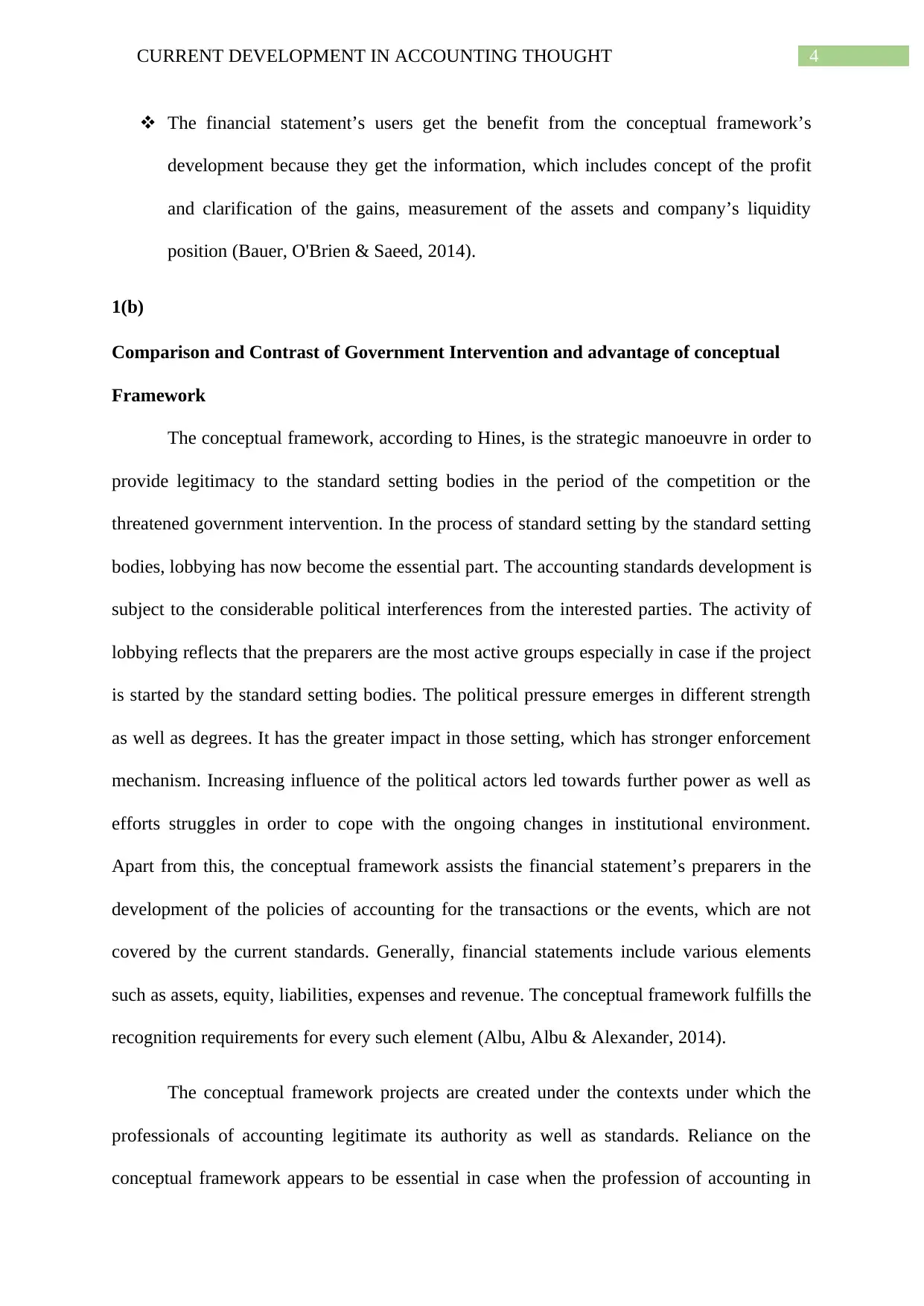
4CURRENT DEVELOPMENT IN ACCOUNTING THOUGHT
The financial statement’s users get the benefit from the conceptual framework’s
development because they get the information, which includes concept of the profit
and clarification of the gains, measurement of the assets and company’s liquidity
position (Bauer, O'Brien & Saeed, 2014).
1(b)
Comparison and Contrast of Government Intervention and advantage of conceptual
Framework
The conceptual framework, according to Hines, is the strategic manoeuvre in order to
provide legitimacy to the standard setting bodies in the period of the competition or the
threatened government intervention. In the process of standard setting by the standard setting
bodies, lobbying has now become the essential part. The accounting standards development is
subject to the considerable political interferences from the interested parties. The activity of
lobbying reflects that the preparers are the most active groups especially in case if the project
is started by the standard setting bodies. The political pressure emerges in different strength
as well as degrees. It has the greater impact in those setting, which has stronger enforcement
mechanism. Increasing influence of the political actors led towards further power as well as
efforts struggles in order to cope with the ongoing changes in institutional environment.
Apart from this, the conceptual framework assists the financial statement’s preparers in the
development of the policies of accounting for the transactions or the events, which are not
covered by the current standards. Generally, financial statements include various elements
such as assets, equity, liabilities, expenses and revenue. The conceptual framework fulfills the
recognition requirements for every such element (Albu, Albu & Alexander, 2014).
The conceptual framework projects are created under the contexts under which the
professionals of accounting legitimate its authority as well as standards. Reliance on the
conceptual framework appears to be essential in case when the profession of accounting in
The financial statement’s users get the benefit from the conceptual framework’s
development because they get the information, which includes concept of the profit
and clarification of the gains, measurement of the assets and company’s liquidity
position (Bauer, O'Brien & Saeed, 2014).
1(b)
Comparison and Contrast of Government Intervention and advantage of conceptual
Framework
The conceptual framework, according to Hines, is the strategic manoeuvre in order to
provide legitimacy to the standard setting bodies in the period of the competition or the
threatened government intervention. In the process of standard setting by the standard setting
bodies, lobbying has now become the essential part. The accounting standards development is
subject to the considerable political interferences from the interested parties. The activity of
lobbying reflects that the preparers are the most active groups especially in case if the project
is started by the standard setting bodies. The political pressure emerges in different strength
as well as degrees. It has the greater impact in those setting, which has stronger enforcement
mechanism. Increasing influence of the political actors led towards further power as well as
efforts struggles in order to cope with the ongoing changes in institutional environment.
Apart from this, the conceptual framework assists the financial statement’s preparers in the
development of the policies of accounting for the transactions or the events, which are not
covered by the current standards. Generally, financial statements include various elements
such as assets, equity, liabilities, expenses and revenue. The conceptual framework fulfills the
recognition requirements for every such element (Albu, Albu & Alexander, 2014).
The conceptual framework projects are created under the contexts under which the
professionals of accounting legitimate its authority as well as standards. Reliance on the
conceptual framework appears to be essential in case when the profession of accounting in
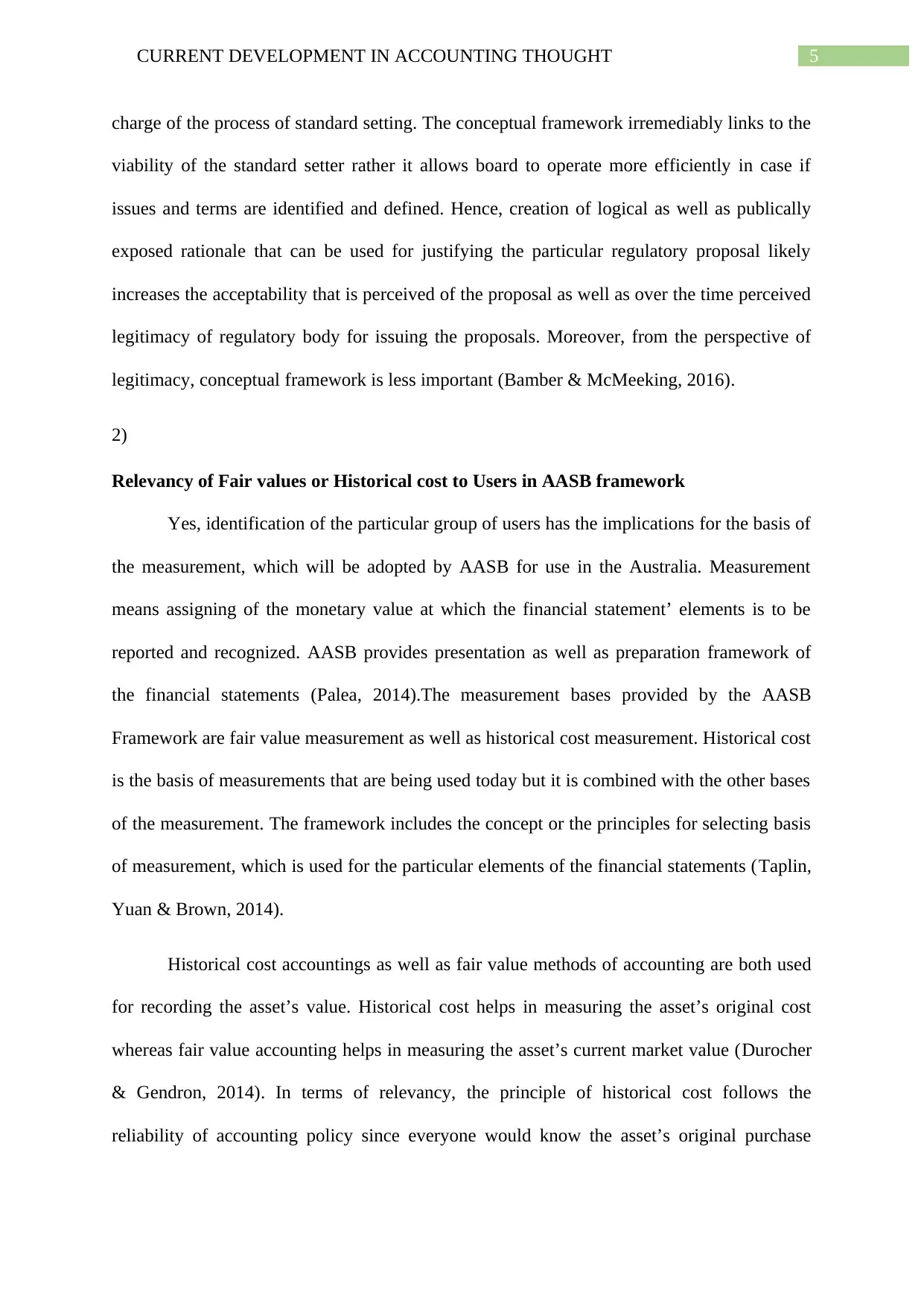
5CURRENT DEVELOPMENT IN ACCOUNTING THOUGHT
charge of the process of standard setting. The conceptual framework irremediably links to the
viability of the standard setter rather it allows board to operate more efficiently in case if
issues and terms are identified and defined. Hence, creation of logical as well as publically
exposed rationale that can be used for justifying the particular regulatory proposal likely
increases the acceptability that is perceived of the proposal as well as over the time perceived
legitimacy of regulatory body for issuing the proposals. Moreover, from the perspective of
legitimacy, conceptual framework is less important (Bamber & McMeeking, 2016).
2)
Relevancy of Fair values or Historical cost to Users in AASB framework
Yes, identification of the particular group of users has the implications for the basis of
the measurement, which will be adopted by AASB for use in the Australia. Measurement
means assigning of the monetary value at which the financial statement’ elements is to be
reported and recognized. AASB provides presentation as well as preparation framework of
the financial statements (Palea, 2014).The measurement bases provided by the AASB
Framework are fair value measurement as well as historical cost measurement. Historical cost
is the basis of measurements that are being used today but it is combined with the other bases
of the measurement. The framework includes the concept or the principles for selecting basis
of measurement, which is used for the particular elements of the financial statements (Taplin,
Yuan & Brown, 2014).
Historical cost accountings as well as fair value methods of accounting are both used
for recording the asset’s value. Historical cost helps in measuring the asset’s original cost
whereas fair value accounting helps in measuring the asset’s current market value (Durocher
& Gendron, 2014). In terms of relevancy, the principle of historical cost follows the
reliability of accounting policy since everyone would know the asset’s original purchase
charge of the process of standard setting. The conceptual framework irremediably links to the
viability of the standard setter rather it allows board to operate more efficiently in case if
issues and terms are identified and defined. Hence, creation of logical as well as publically
exposed rationale that can be used for justifying the particular regulatory proposal likely
increases the acceptability that is perceived of the proposal as well as over the time perceived
legitimacy of regulatory body for issuing the proposals. Moreover, from the perspective of
legitimacy, conceptual framework is less important (Bamber & McMeeking, 2016).
2)
Relevancy of Fair values or Historical cost to Users in AASB framework
Yes, identification of the particular group of users has the implications for the basis of
the measurement, which will be adopted by AASB for use in the Australia. Measurement
means assigning of the monetary value at which the financial statement’ elements is to be
reported and recognized. AASB provides presentation as well as preparation framework of
the financial statements (Palea, 2014).The measurement bases provided by the AASB
Framework are fair value measurement as well as historical cost measurement. Historical cost
is the basis of measurements that are being used today but it is combined with the other bases
of the measurement. The framework includes the concept or the principles for selecting basis
of measurement, which is used for the particular elements of the financial statements (Taplin,
Yuan & Brown, 2014).
Historical cost accountings as well as fair value methods of accounting are both used
for recording the asset’s value. Historical cost helps in measuring the asset’s original cost
whereas fair value accounting helps in measuring the asset’s current market value (Durocher
& Gendron, 2014). In terms of relevancy, the principle of historical cost follows the
reliability of accounting policy since everyone would know the asset’s original purchase
⊘ This is a preview!⊘
Do you want full access?
Subscribe today to unlock all pages.

Trusted by 1+ million students worldwide
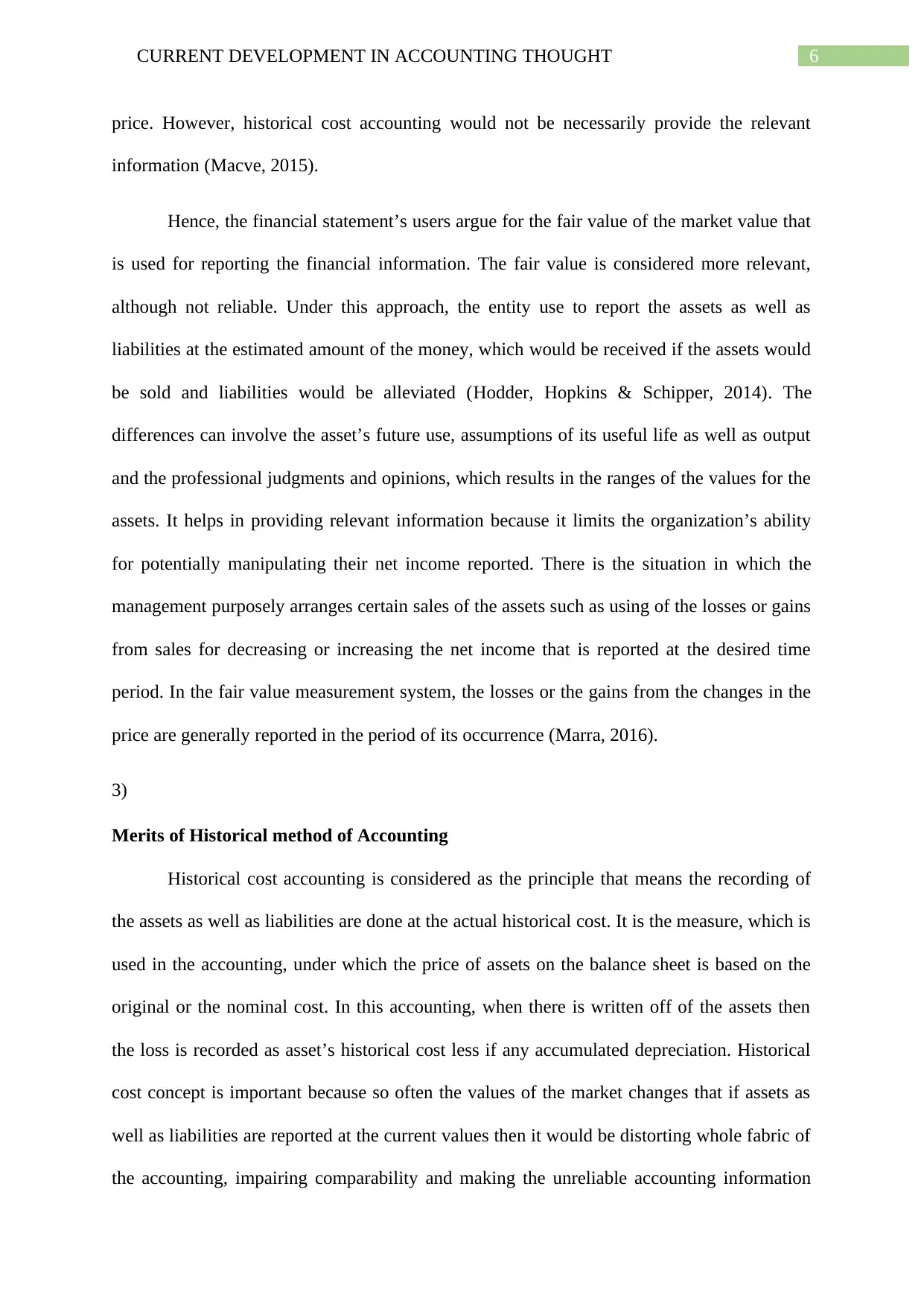
6CURRENT DEVELOPMENT IN ACCOUNTING THOUGHT
price. However, historical cost accounting would not be necessarily provide the relevant
information (Macve, 2015).
Hence, the financial statement’s users argue for the fair value of the market value that
is used for reporting the financial information. The fair value is considered more relevant,
although not reliable. Under this approach, the entity use to report the assets as well as
liabilities at the estimated amount of the money, which would be received if the assets would
be sold and liabilities would be alleviated (Hodder, Hopkins & Schipper, 2014). The
differences can involve the asset’s future use, assumptions of its useful life as well as output
and the professional judgments and opinions, which results in the ranges of the values for the
assets. It helps in providing relevant information because it limits the organization’s ability
for potentially manipulating their net income reported. There is the situation in which the
management purposely arranges certain sales of the assets such as using of the losses or gains
from sales for decreasing or increasing the net income that is reported at the desired time
period. In the fair value measurement system, the losses or the gains from the changes in the
price are generally reported in the period of its occurrence (Marra, 2016).
3)
Merits of Historical method of Accounting
Historical cost accounting is considered as the principle that means the recording of
the assets as well as liabilities are done at the actual historical cost. It is the measure, which is
used in the accounting, under which the price of assets on the balance sheet is based on the
original or the nominal cost. In this accounting, when there is written off of the assets then
the loss is recorded as asset’s historical cost less if any accumulated depreciation. Historical
cost concept is important because so often the values of the market changes that if assets as
well as liabilities are reported at the current values then it would be distorting whole fabric of
the accounting, impairing comparability and making the unreliable accounting information
price. However, historical cost accounting would not be necessarily provide the relevant
information (Macve, 2015).
Hence, the financial statement’s users argue for the fair value of the market value that
is used for reporting the financial information. The fair value is considered more relevant,
although not reliable. Under this approach, the entity use to report the assets as well as
liabilities at the estimated amount of the money, which would be received if the assets would
be sold and liabilities would be alleviated (Hodder, Hopkins & Schipper, 2014). The
differences can involve the asset’s future use, assumptions of its useful life as well as output
and the professional judgments and opinions, which results in the ranges of the values for the
assets. It helps in providing relevant information because it limits the organization’s ability
for potentially manipulating their net income reported. There is the situation in which the
management purposely arranges certain sales of the assets such as using of the losses or gains
from sales for decreasing or increasing the net income that is reported at the desired time
period. In the fair value measurement system, the losses or the gains from the changes in the
price are generally reported in the period of its occurrence (Marra, 2016).
3)
Merits of Historical method of Accounting
Historical cost accounting is considered as the principle that means the recording of
the assets as well as liabilities are done at the actual historical cost. It is the measure, which is
used in the accounting, under which the price of assets on the balance sheet is based on the
original or the nominal cost. In this accounting, when there is written off of the assets then
the loss is recorded as asset’s historical cost less if any accumulated depreciation. Historical
cost concept is important because so often the values of the market changes that if assets as
well as liabilities are reported at the current values then it would be distorting whole fabric of
the accounting, impairing comparability and making the unreliable accounting information
Paraphrase This Document
Need a fresh take? Get an instant paraphrase of this document with our AI Paraphraser
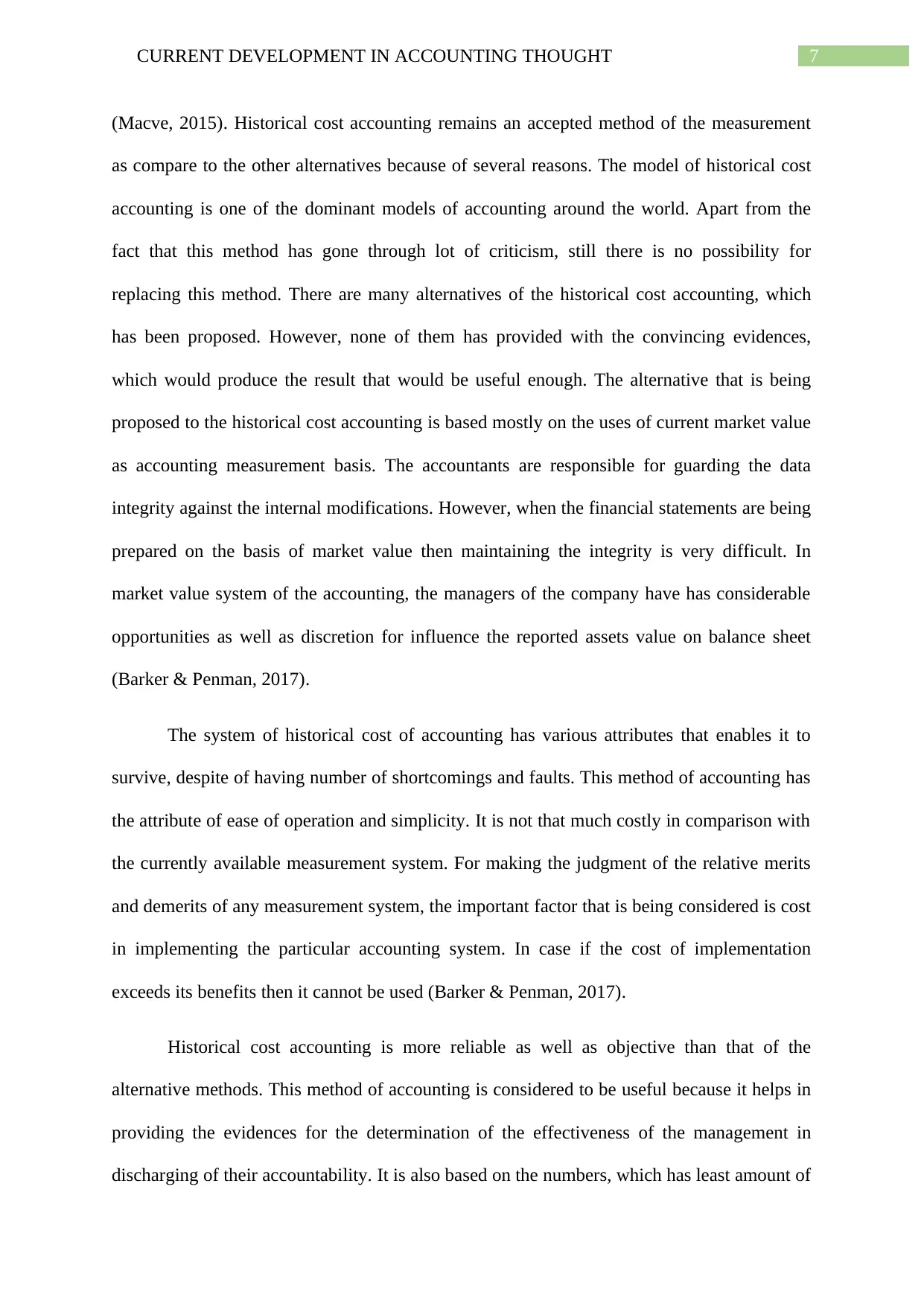
7CURRENT DEVELOPMENT IN ACCOUNTING THOUGHT
(Macve, 2015). Historical cost accounting remains an accepted method of the measurement
as compare to the other alternatives because of several reasons. The model of historical cost
accounting is one of the dominant models of accounting around the world. Apart from the
fact that this method has gone through lot of criticism, still there is no possibility for
replacing this method. There are many alternatives of the historical cost accounting, which
has been proposed. However, none of them has provided with the convincing evidences,
which would produce the result that would be useful enough. The alternative that is being
proposed to the historical cost accounting is based mostly on the uses of current market value
as accounting measurement basis. The accountants are responsible for guarding the data
integrity against the internal modifications. However, when the financial statements are being
prepared on the basis of market value then maintaining the integrity is very difficult. In
market value system of the accounting, the managers of the company have has considerable
opportunities as well as discretion for influence the reported assets value on balance sheet
(Barker & Penman, 2017).
The system of historical cost of accounting has various attributes that enables it to
survive, despite of having number of shortcomings and faults. This method of accounting has
the attribute of ease of operation and simplicity. It is not that much costly in comparison with
the currently available measurement system. For making the judgment of the relative merits
and demerits of any measurement system, the important factor that is being considered is cost
in implementing the particular accounting system. In case if the cost of implementation
exceeds its benefits then it cannot be used (Barker & Penman, 2017).
Historical cost accounting is more reliable as well as objective than that of the
alternative methods. This method of accounting is considered to be useful because it helps in
providing the evidences for the determination of the effectiveness of the management in
discharging of their accountability. It is also based on the numbers, which has least amount of
(Macve, 2015). Historical cost accounting remains an accepted method of the measurement
as compare to the other alternatives because of several reasons. The model of historical cost
accounting is one of the dominant models of accounting around the world. Apart from the
fact that this method has gone through lot of criticism, still there is no possibility for
replacing this method. There are many alternatives of the historical cost accounting, which
has been proposed. However, none of them has provided with the convincing evidences,
which would produce the result that would be useful enough. The alternative that is being
proposed to the historical cost accounting is based mostly on the uses of current market value
as accounting measurement basis. The accountants are responsible for guarding the data
integrity against the internal modifications. However, when the financial statements are being
prepared on the basis of market value then maintaining the integrity is very difficult. In
market value system of the accounting, the managers of the company have has considerable
opportunities as well as discretion for influence the reported assets value on balance sheet
(Barker & Penman, 2017).
The system of historical cost of accounting has various attributes that enables it to
survive, despite of having number of shortcomings and faults. This method of accounting has
the attribute of ease of operation and simplicity. It is not that much costly in comparison with
the currently available measurement system. For making the judgment of the relative merits
and demerits of any measurement system, the important factor that is being considered is cost
in implementing the particular accounting system. In case if the cost of implementation
exceeds its benefits then it cannot be used (Barker & Penman, 2017).
Historical cost accounting is more reliable as well as objective than that of the
alternative methods. This method of accounting is considered to be useful because it helps in
providing the evidences for the determination of the effectiveness of the management in
discharging of their accountability. It is also based on the numbers, which has least amount of
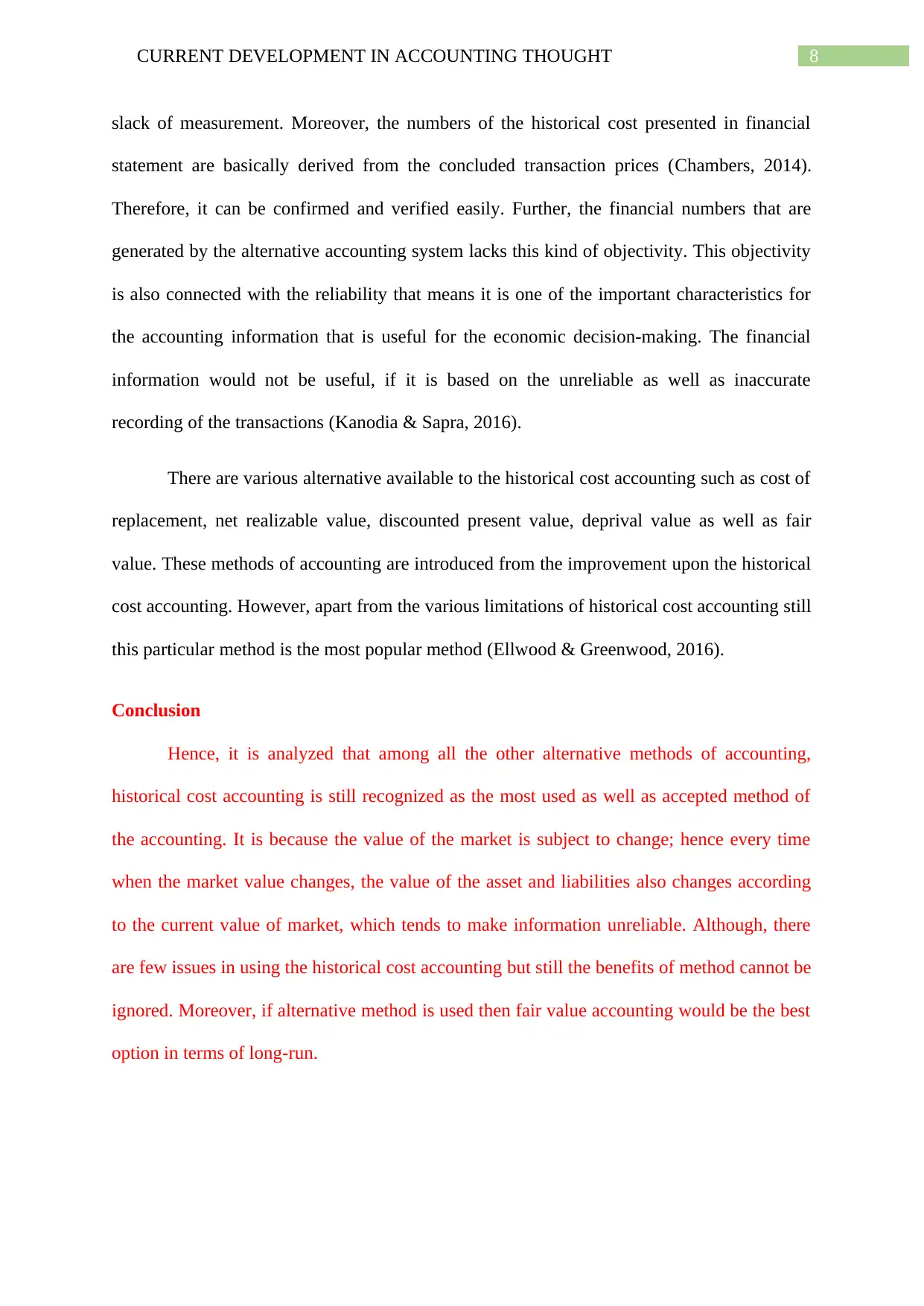
8CURRENT DEVELOPMENT IN ACCOUNTING THOUGHT
slack of measurement. Moreover, the numbers of the historical cost presented in financial
statement are basically derived from the concluded transaction prices (Chambers, 2014).
Therefore, it can be confirmed and verified easily. Further, the financial numbers that are
generated by the alternative accounting system lacks this kind of objectivity. This objectivity
is also connected with the reliability that means it is one of the important characteristics for
the accounting information that is useful for the economic decision-making. The financial
information would not be useful, if it is based on the unreliable as well as inaccurate
recording of the transactions (Kanodia & Sapra, 2016).
There are various alternative available to the historical cost accounting such as cost of
replacement, net realizable value, discounted present value, deprival value as well as fair
value. These methods of accounting are introduced from the improvement upon the historical
cost accounting. However, apart from the various limitations of historical cost accounting still
this particular method is the most popular method (Ellwood & Greenwood, 2016).
Conclusion
Hence, it is analyzed that among all the other alternative methods of accounting,
historical cost accounting is still recognized as the most used as well as accepted method of
the accounting. It is because the value of the market is subject to change; hence every time
when the market value changes, the value of the asset and liabilities also changes according
to the current value of market, which tends to make information unreliable. Although, there
are few issues in using the historical cost accounting but still the benefits of method cannot be
ignored. Moreover, if alternative method is used then fair value accounting would be the best
option in terms of long-run.
slack of measurement. Moreover, the numbers of the historical cost presented in financial
statement are basically derived from the concluded transaction prices (Chambers, 2014).
Therefore, it can be confirmed and verified easily. Further, the financial numbers that are
generated by the alternative accounting system lacks this kind of objectivity. This objectivity
is also connected with the reliability that means it is one of the important characteristics for
the accounting information that is useful for the economic decision-making. The financial
information would not be useful, if it is based on the unreliable as well as inaccurate
recording of the transactions (Kanodia & Sapra, 2016).
There are various alternative available to the historical cost accounting such as cost of
replacement, net realizable value, discounted present value, deprival value as well as fair
value. These methods of accounting are introduced from the improvement upon the historical
cost accounting. However, apart from the various limitations of historical cost accounting still
this particular method is the most popular method (Ellwood & Greenwood, 2016).
Conclusion
Hence, it is analyzed that among all the other alternative methods of accounting,
historical cost accounting is still recognized as the most used as well as accepted method of
the accounting. It is because the value of the market is subject to change; hence every time
when the market value changes, the value of the asset and liabilities also changes according
to the current value of market, which tends to make information unreliable. Although, there
are few issues in using the historical cost accounting but still the benefits of method cannot be
ignored. Moreover, if alternative method is used then fair value accounting would be the best
option in terms of long-run.
⊘ This is a preview!⊘
Do you want full access?
Subscribe today to unlock all pages.

Trusted by 1+ million students worldwide
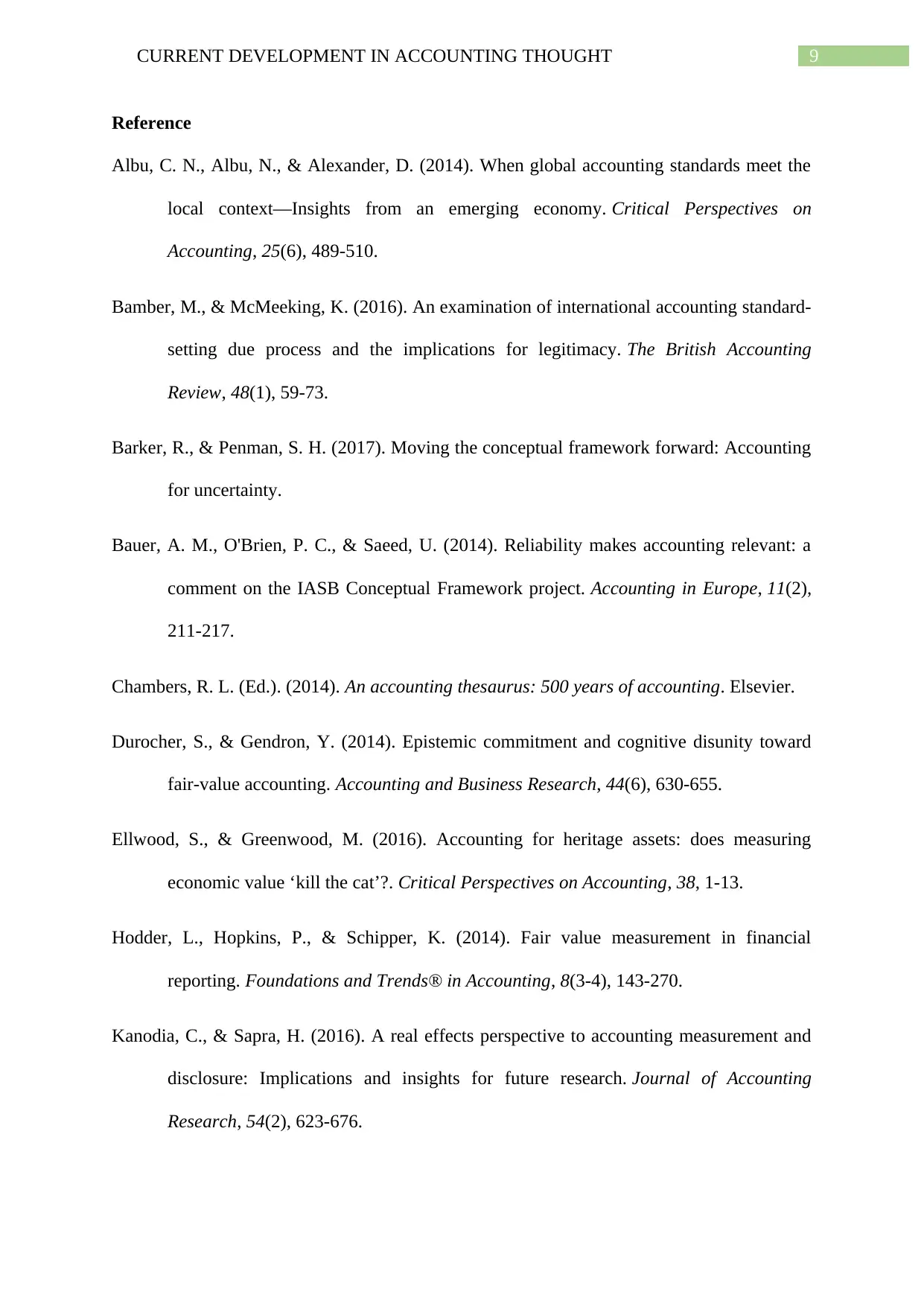
9CURRENT DEVELOPMENT IN ACCOUNTING THOUGHT
Reference
Albu, C. N., Albu, N., & Alexander, D. (2014). When global accounting standards meet the
local context—Insights from an emerging economy. Critical Perspectives on
Accounting, 25(6), 489-510.
Bamber, M., & McMeeking, K. (2016). An examination of international accounting standard-
setting due process and the implications for legitimacy. The British Accounting
Review, 48(1), 59-73.
Barker, R., & Penman, S. H. (2017). Moving the conceptual framework forward: Accounting
for uncertainty.
Bauer, A. M., O'Brien, P. C., & Saeed, U. (2014). Reliability makes accounting relevant: a
comment on the IASB Conceptual Framework project. Accounting in Europe, 11(2),
211-217.
Chambers, R. L. (Ed.). (2014). An accounting thesaurus: 500 years of accounting. Elsevier.
Durocher, S., & Gendron, Y. (2014). Epistemic commitment and cognitive disunity toward
fair-value accounting. Accounting and Business Research, 44(6), 630-655.
Ellwood, S., & Greenwood, M. (2016). Accounting for heritage assets: does measuring
economic value ‘kill the cat’?. Critical Perspectives on Accounting, 38, 1-13.
Hodder, L., Hopkins, P., & Schipper, K. (2014). Fair value measurement in financial
reporting. Foundations and Trends® in Accounting, 8(3-4), 143-270.
Kanodia, C., & Sapra, H. (2016). A real effects perspective to accounting measurement and
disclosure: Implications and insights for future research. Journal of Accounting
Research, 54(2), 623-676.
Reference
Albu, C. N., Albu, N., & Alexander, D. (2014). When global accounting standards meet the
local context—Insights from an emerging economy. Critical Perspectives on
Accounting, 25(6), 489-510.
Bamber, M., & McMeeking, K. (2016). An examination of international accounting standard-
setting due process and the implications for legitimacy. The British Accounting
Review, 48(1), 59-73.
Barker, R., & Penman, S. H. (2017). Moving the conceptual framework forward: Accounting
for uncertainty.
Bauer, A. M., O'Brien, P. C., & Saeed, U. (2014). Reliability makes accounting relevant: a
comment on the IASB Conceptual Framework project. Accounting in Europe, 11(2),
211-217.
Chambers, R. L. (Ed.). (2014). An accounting thesaurus: 500 years of accounting. Elsevier.
Durocher, S., & Gendron, Y. (2014). Epistemic commitment and cognitive disunity toward
fair-value accounting. Accounting and Business Research, 44(6), 630-655.
Ellwood, S., & Greenwood, M. (2016). Accounting for heritage assets: does measuring
economic value ‘kill the cat’?. Critical Perspectives on Accounting, 38, 1-13.
Hodder, L., Hopkins, P., & Schipper, K. (2014). Fair value measurement in financial
reporting. Foundations and Trends® in Accounting, 8(3-4), 143-270.
Kanodia, C., & Sapra, H. (2016). A real effects perspective to accounting measurement and
disclosure: Implications and insights for future research. Journal of Accounting
Research, 54(2), 623-676.
Paraphrase This Document
Need a fresh take? Get an instant paraphrase of this document with our AI Paraphraser
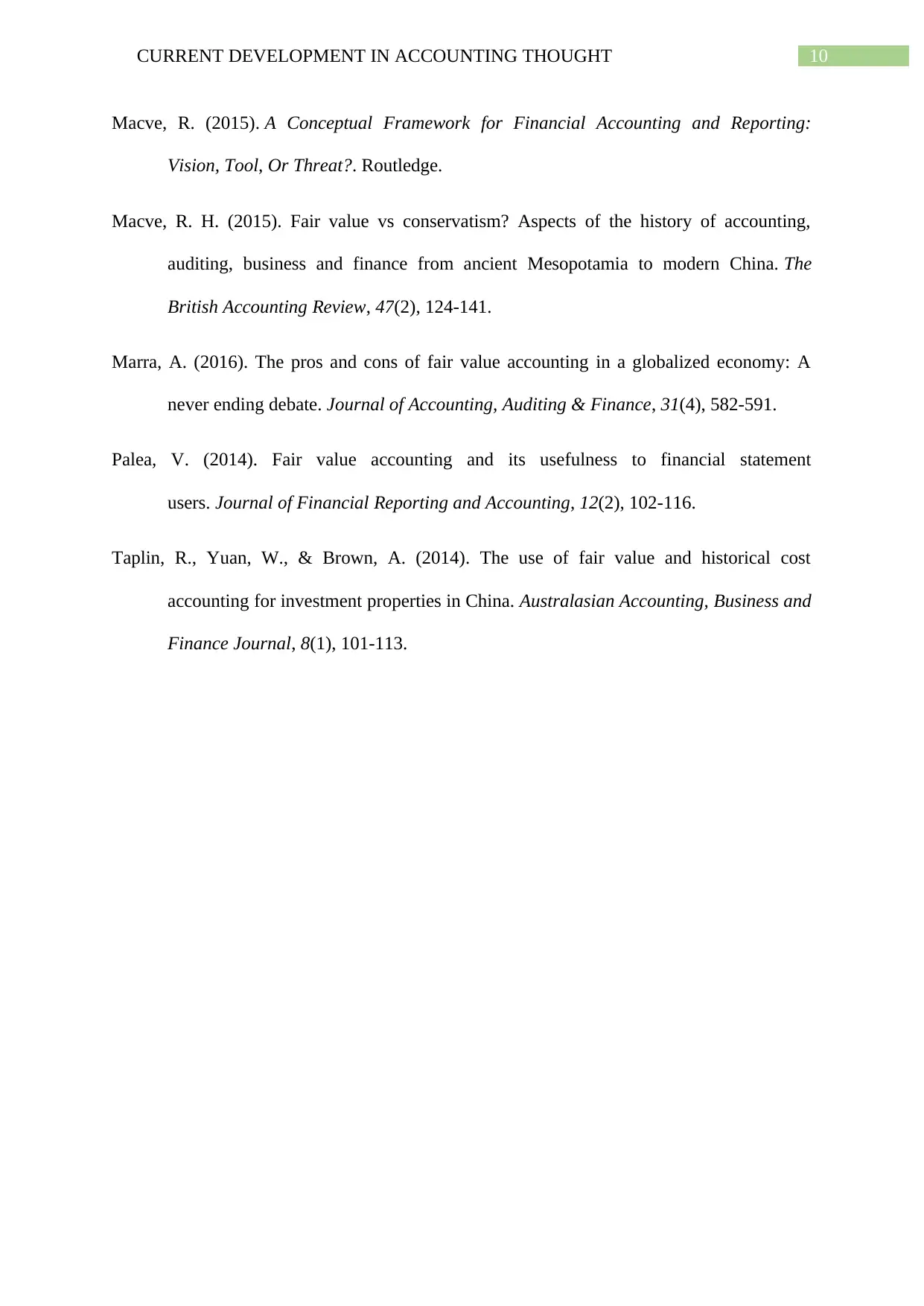
10CURRENT DEVELOPMENT IN ACCOUNTING THOUGHT
Macve, R. (2015). A Conceptual Framework for Financial Accounting and Reporting:
Vision, Tool, Or Threat?. Routledge.
Macve, R. H. (2015). Fair value vs conservatism? Aspects of the history of accounting,
auditing, business and finance from ancient Mesopotamia to modern China. The
British Accounting Review, 47(2), 124-141.
Marra, A. (2016). The pros and cons of fair value accounting in a globalized economy: A
never ending debate. Journal of Accounting, Auditing & Finance, 31(4), 582-591.
Palea, V. (2014). Fair value accounting and its usefulness to financial statement
users. Journal of Financial Reporting and Accounting, 12(2), 102-116.
Taplin, R., Yuan, W., & Brown, A. (2014). The use of fair value and historical cost
accounting for investment properties in China. Australasian Accounting, Business and
Finance Journal, 8(1), 101-113.
Macve, R. (2015). A Conceptual Framework for Financial Accounting and Reporting:
Vision, Tool, Or Threat?. Routledge.
Macve, R. H. (2015). Fair value vs conservatism? Aspects of the history of accounting,
auditing, business and finance from ancient Mesopotamia to modern China. The
British Accounting Review, 47(2), 124-141.
Marra, A. (2016). The pros and cons of fair value accounting in a globalized economy: A
never ending debate. Journal of Accounting, Auditing & Finance, 31(4), 582-591.
Palea, V. (2014). Fair value accounting and its usefulness to financial statement
users. Journal of Financial Reporting and Accounting, 12(2), 102-116.
Taplin, R., Yuan, W., & Brown, A. (2014). The use of fair value and historical cost
accounting for investment properties in China. Australasian Accounting, Business and
Finance Journal, 8(1), 101-113.
1 out of 11
Related Documents
Your All-in-One AI-Powered Toolkit for Academic Success.
+13062052269
info@desklib.com
Available 24*7 on WhatsApp / Email
![[object Object]](/_next/static/media/star-bottom.7253800d.svg)
Unlock your academic potential
Copyright © 2020–2025 A2Z Services. All Rights Reserved. Developed and managed by ZUCOL.




